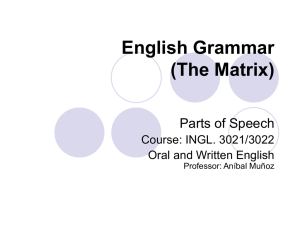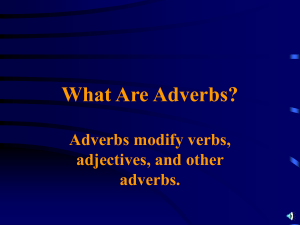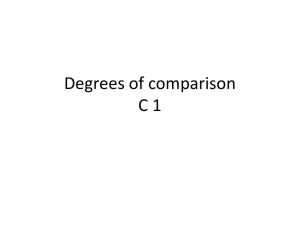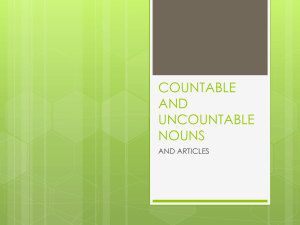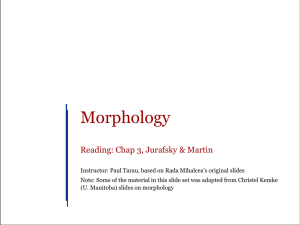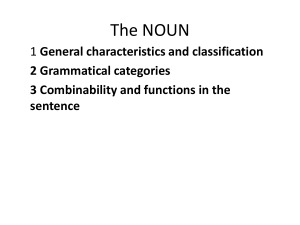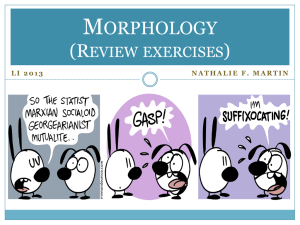Parts of speech & Lexical Categories
advertisement
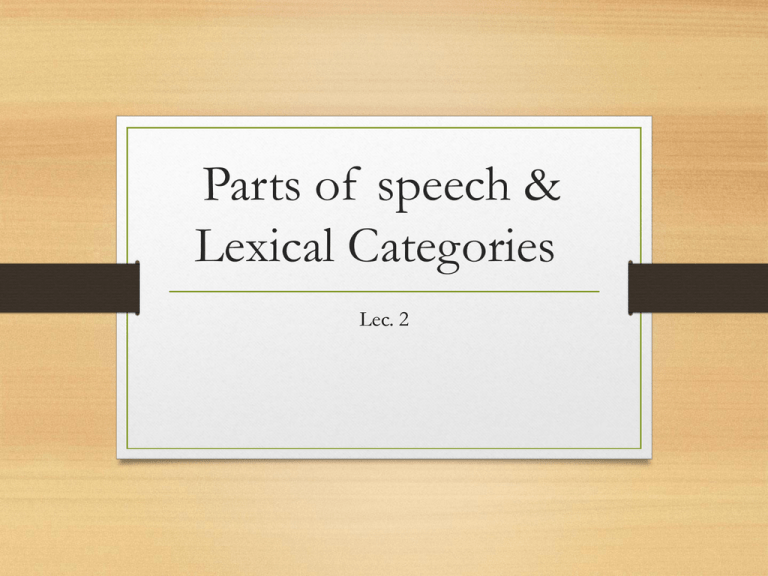
Parts of speech & Lexical Categories Lec. 2 Parts of Speech • Syntactic categories or parts of speech are the groups of words that let us state rules and constraints about the form of sentences. • • • • Nouns (N) Verbs (V.) Adjectives (Adj.) Adverbs (Adv.) Traditional Semantic Definitions • Noun: word describing a person, place, or thing • Verb: Word describing an action, occurrence or state of being • Adjective: Word that expresses quality, quantity or extent • Adverb: Word that expresses manner, quality, place, time, degree, number, cause, opposition, affirmation or denial Note • These definitions are based on meaning or semantics • Note: • Parts of speech are based on their distribution, not meaning. Distribution refers to the places the word appears, both with respect to the prefixes and suffixes the word has on it. Exercise The following sentence has a number of nonsense words in it. Can you tell what part of speech they are? The yinkish dripner blorked quastofically into the nidin with the pidibs. N V Adj. Adv. Distributional criteria for identifying NOUNS • Derivational suffixes: In English, nouns often end in derivational endings, such as (-ment), (-ness), (-ity), (-ion), (-ation), (-ist), (ant), (-ee), (-hood), (-aire), etc. • Inflectional suffixes: Nouns in English don’t show much inflection, but when pluralized can take suffixes such as (-s), (-es), (en), (-ren), etc. Distributional criteria for identifying NOUNS • Syntactic distribution: Nouns often appear after determiners such as the, these, those, and can appear after adjectives . Nouns can also follow prepositions. And all these conditions can happen together. E.g. In the big gymnasium • Nouns can appear as the subject of the sentence, the as the direct object. Nouns can be negated by no. e.g. no apples were eaten Distributional criteria for identifying VERBS • Derivational suffixes: Verbs often end in derivational endings, such as (-ate) and (ize/-ise) • Inflectional suffixes: Past tense (-t / -ed) Present tense 3rd person singular (-s) Progressive (-ing) Passivized (-ed/-en) Distributional criteria for identifying VERBS • Syntactic distribution: Verbs can follow auxiliaries & modals, such as (will, have, having, had, has, am, be, been, being, is, are, were, was, would, can, could, shall, should) the typical infinitive (to) Verbs follow subjects, and can follow adverbs such as (often) & (frequently). Verbs can be negated with (not) Distributional criteria for identifying ADJECTIVES • Derivational suffixes: Adjectives often end in derivational endings such as (-ing), (-ive), (able), (-al), (-ate), (-ish), (-some), (i-an), (-ful), (-less), & (-ly) • Inflectional suffixes: Adjectives can be inflected into a comparative form using (-er), (alternately they follow the word more) They can also be inflected into their superlative form using (-est) Adjectives are typically negated using the prefixes (-un, -in, im) Distributional criteria for identifying ADJECTIVES • Syntactic distribution: Adjectives can appear between determiners, such as (the, a, an, these, those, etc. & nouns (the big peanut) They also can follow the auxiliary (am, is, are, was, were, be, been, being) Adjectives can be modified by the adverb (very) Adjectives can also appear in (as…..as…...) constructions Distributional criteria for identifying ADVERBS • Derivational suffixes: Many adverbs end in (-ly) • Inflectional suffixes: Adverbs generally do not take inflectional affixes. However, on rare occasions they can be used comparatively & follow the word (more). e.g. she went more quickly than he did Adverbs typically do not take the prefix (-un) unless the adjective they are derived from does first e.g. unhelpfully (unhelpful) Distributional criteria for identifying ADVERBS • Syntactic distribution: The syntactic distribution of adverbs is most easily described by stating where they can’t appear. Adverbs can’t appear between a determiner & a noun e.g. * the quickly fox or after the verb (is) and it’s variants They can really appear pretty much anywhere else in the sentence, although they typically appear at the beginning or end of sentences Like adjectives, they can be modified by the adverb (very), or appear in (as…..as…...) Exercise underline all N, V, Adj. & Adv. “If you’ll watch my feet, you will see how I do it”. She said; and lifting her skirt above her dainty ankles, glided across the floor on tiptoe, as lightly as a fawn at play. But Sidney Trove was not a graceful creature. The muscles on his lithe form, developed in the school of work or in feats of strength at which he had met no equal, were untrained in all graceful trickery. He loved dancing and music and everything that increased the beauty and delight of life, but they filled him with a deep regret of his ignorance. Note • Parts of speech are not always obvious or straightforward. • It requires some practice & some experience. Q7 Exercise • Identify the main parts of speech (N, V, Adj. & Adv.) in the following sentences: 1. The old rusty stove exploded in the house quickly yesterday. 2. The brainy assistant often put vital files through the new efficient shredder. 3. The large evil leathery tiger complained to his aging keeper about his unappetizing snacks. 4. I’ve just eaten the last piece of cake.




